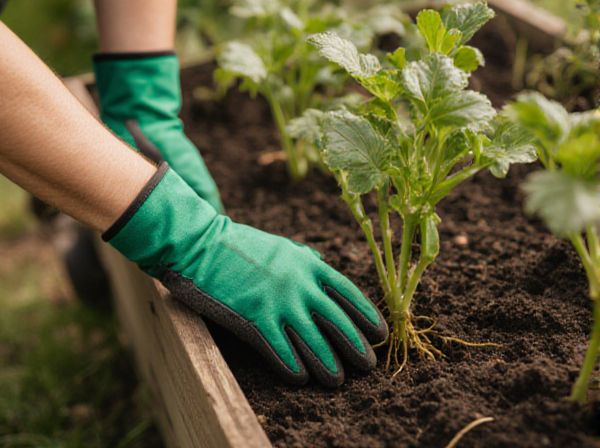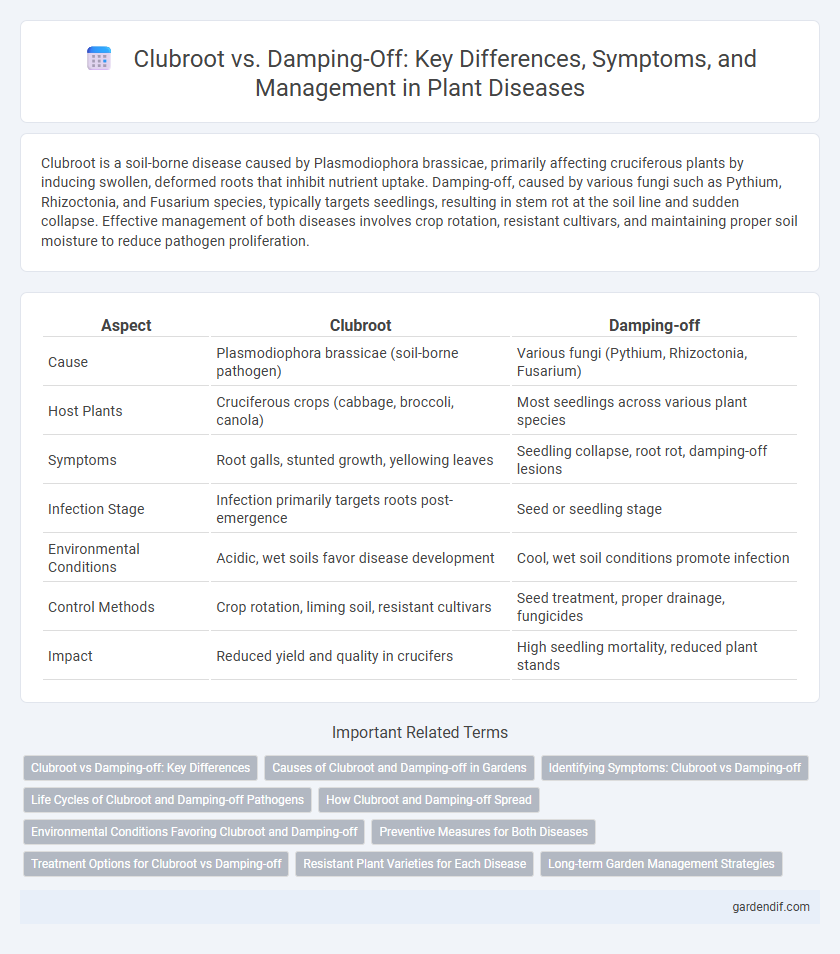
Clubroot vs Damping-off Illustration
Clubroot is a soil-borne disease caused by Plasmodiophora brassicae, primarily affecting cruciferous plants by inducing swollen, deformed roots that inhibit nutrient uptake. Damping-off, caused by various fungi such as Pythium, Rhizoctonia, and Fusarium species, typically targets seedlings, resulting in stem rot at the soil line and sudden collapse. Effective management of both diseases involves crop rotation, resistant cultivars, and maintaining proper soil moisture to reduce pathogen proliferation.
Table of Comparison
| Aspect | Clubroot | Damping-off |
|---|---|---|
| Cause | Plasmodiophora brassicae (soil-borne pathogen) | Various fungi (Pythium, Rhizoctonia, Fusarium) |
| Host Plants | Cruciferous crops (cabbage, broccoli, canola) | Most seedlings across various plant species |
| Symptoms | Root galls, stunted growth, yellowing leaves | Seedling collapse, root rot, damping-off lesions |
| Infection Stage | Infection primarily targets roots post-emergence | Seed or seedling stage |
| Environmental Conditions | Acidic, wet soils favor disease development | Cool, wet soil conditions promote infection |
| Control Methods | Crop rotation, liming soil, resistant cultivars | Seed treatment, proper drainage, fungicides |
| Impact | Reduced yield and quality in crucifers | High seedling mortality, reduced plant stands |
Clubroot vs Damping-off: Key Differences
Clubroot primarily affects the roots of cruciferous plants, causing swollen galls that disrupt nutrient and water uptake, whereas damping-off targets seedlings, leading to rapid stem and root decay near the soil line. Clubroot is caused by the soil-borne pathogen *Plasmodiophora brassicae*, while damping-off results from fungi such as *Pythium*, *Rhizoctonia*, and *Fusarium* species. Management of clubroot involves crop rotation and soil pH adjustment, contrasting with damping-off prevention strategies that emphasize seed treatment and optimal soil moisture control.
Causes of Clubroot and Damping-off in Gardens
Clubroot is caused by the soil-borne pathogen Plasmodiophora brassicae, which thrives in acidic, poorly drained soils and primarily attacks members of the Brassicaceae family. Damping-off results from fungal pathogens such as Pythium, Rhizoctonia, and Fusarium species, which attack seedlings in overly moist and compacted soil conditions. Understanding these distinct pathogen types and their favored environments is essential for preventing and managing these common garden diseases.
Identifying Symptoms: Clubroot vs Damping-off
Clubroot manifests as swollen, distorted roots with characteristic galls that disrupt nutrient uptake, primarily affecting cruciferous crops. Damping-off presents early seedling wilting, stem constriction near the soil line, and eventual collapse due to fungal infection in moist soil conditions. Accurate identification hinges on root examination for galls in Clubroot versus stem lesions and rapid seedling death in Damping-off.
Life Cycles of Clubroot and Damping-off Pathogens
Clubroot, caused by the pathogen Plasmodiophora brassicae, completes its life cycle through soil-borne resting spores that germinate and infect root hairs, leading to the formation of galls that disrupt nutrient flow. Damping-off, primarily caused by soil fungi such as Pythium, Rhizoctonia, and Fusarium species, initiates infection at seeds or seedlings, rapidly killing young plants through root and stem rot. The life cycle of clubroot involves a prolonged soil phase with spore survival lasting years, whereas damping-off pathogens have shorter generation times with continuous cycles favored by moist and cool soil conditions.
How Clubroot and Damping-off Spread
Clubroot spreads primarily through soil contaminated with the Plasmodiophora brassicae pathogen, which can persist for years and infect cruciferous crops via root hairs and wounds. Damping-off is caused by soil-borne fungi such as Pythium, Rhizoctonia, and Fusarium species that thrive in overly wet and cool conditions, infecting seeds and seedlings at or below the soil surface. Both diseases are facilitated by poor drainage and contaminated soil but differ in their causative agents and infection modes.
Environmental Conditions Favoring Clubroot and Damping-off
Clubroot thrives in acidic, poorly drained soils with a pH below 7 and moist conditions that promote the survival and spread of Plasmodiophora brassicae resting spores. Damping-off is favored by cool, wet, and humid environments combined with poorly ventilated growing areas, which facilitate fungal pathogens such as Pythium, Rhizoctonia, and Fusarium to attack seedlings. Both diseases are exacerbated by waterlogged soils, but clubroot specifically requires prolonged moisture for infection, while damping-off occurs rapidly in saturated, compacted seedbeds.
Preventive Measures for Both Diseases
Effective preventive measures for clubroot include crop rotation with non-host plants like cereals, maintaining soil pH above 7 by liming acidic soils, and using resistant cultivars to reduce pathogen persistence. For damping-off, ensuring well-drained soil, avoiding excessive irrigation, and applying fungicidal seed treatments minimize fungal infection risks. Implementing strict sanitation practices and monitoring soil health are critical to preventing both clubroot and damping-off outbreaks in agricultural settings.
Treatment Options for Clubroot vs Damping-off
Treatment options for clubroot include soil pH adjustment using lime to raise pH above 7.2, crop rotation with non-cruciferous plants, and the use of resistant cultivars. Damping-off management relies on well-drained soil, seed treatment with fungicides such as thiram or captan, and avoiding overwatering to reduce fungal pathogen development. Both diseases benefit from planting disease-free seeds and maintaining proper sanitation to limit pathogen spread.
Resistant Plant Varieties for Each Disease
Clubroot-resistant plant varieties typically possess genes such as CRa and Crr1 that provide immunity against Plasmodiophora brassicae, significantly reducing root galls in cruciferous crops. For damping-off caused by pathogens like Pythium, Phytophthora, and Rhizoctonia, selecting seeds treated with fungicides and resistant varieties like certain cultivars of lettuce and spinach that exhibit enhanced seedling vigor is crucial for prevention. Utilizing genetically resistant cultivars in conjunction with proper crop rotation effectively minimizes the impact of both diseases in agricultural production.
Long-term Garden Management Strategies
Clubroot, caused by Plasmodiophora brassicae, requires long-term crop rotation and soil pH adjustment to above 7.2 to suppress pathogen survival, while damping-off, commonly triggered by various soilborne fungi like Pythium and Phytophthora, demands improved soil drainage and seed treatment for effective prevention. Both diseases benefit from incorporating organic matter to enhance soil health, but clubroot management necessitates several years of rigorous monitoring due to the persistence of resting spores. Resistant cultivars and minimizing soil disturbance also contribute to sustainable garden health by reducing inoculum buildup and disease spread.
Clubroot vs Damping-off Infographic

 gardendif.com
gardendif.com